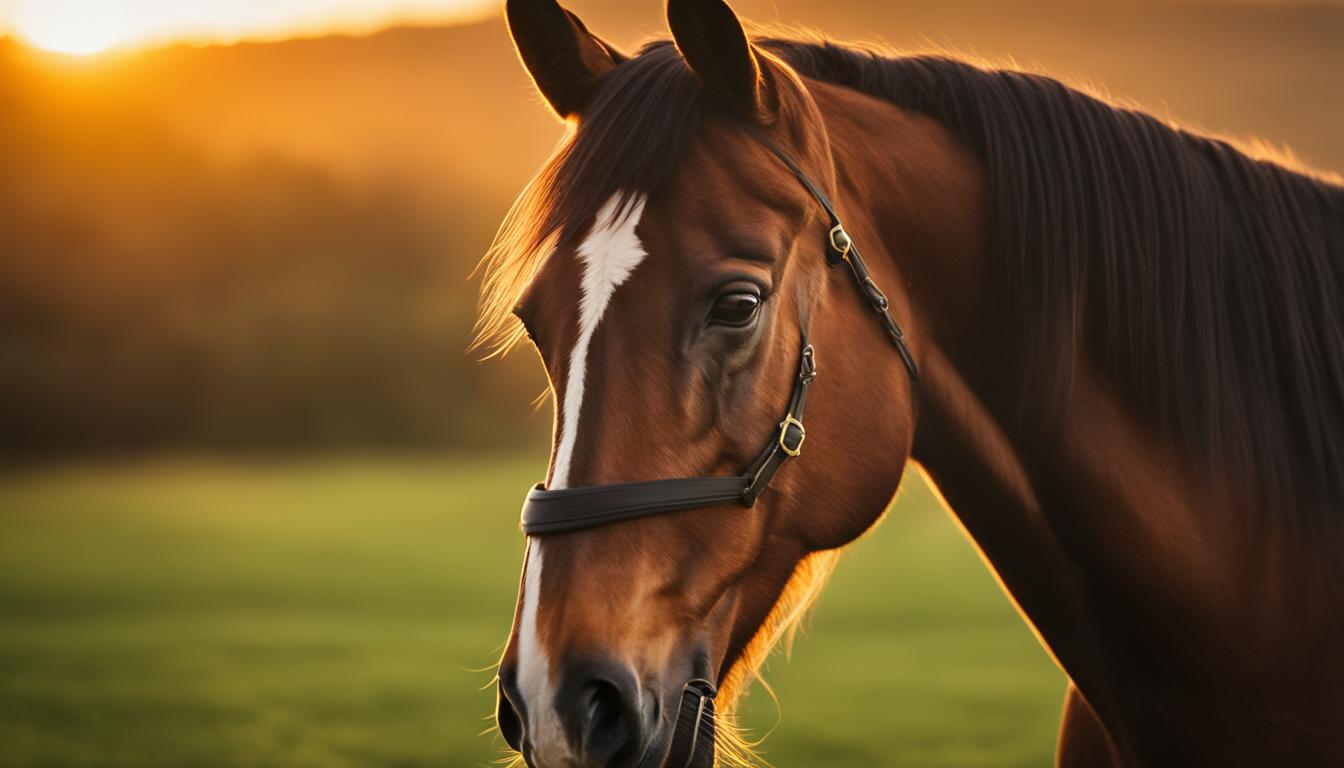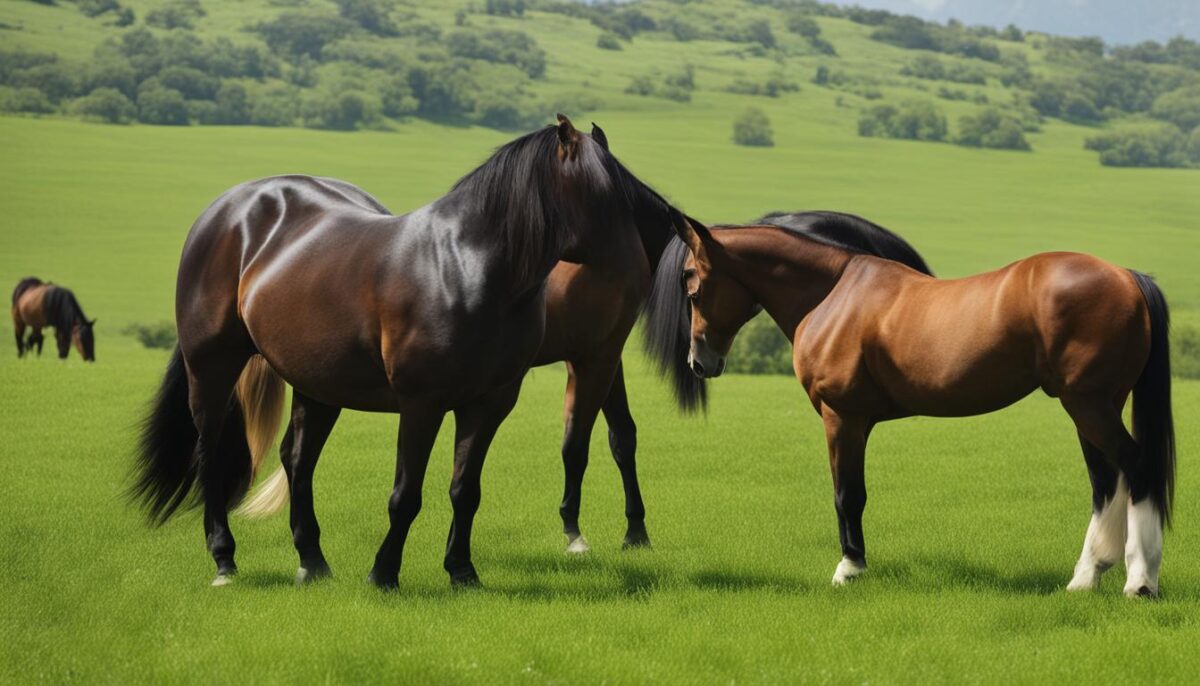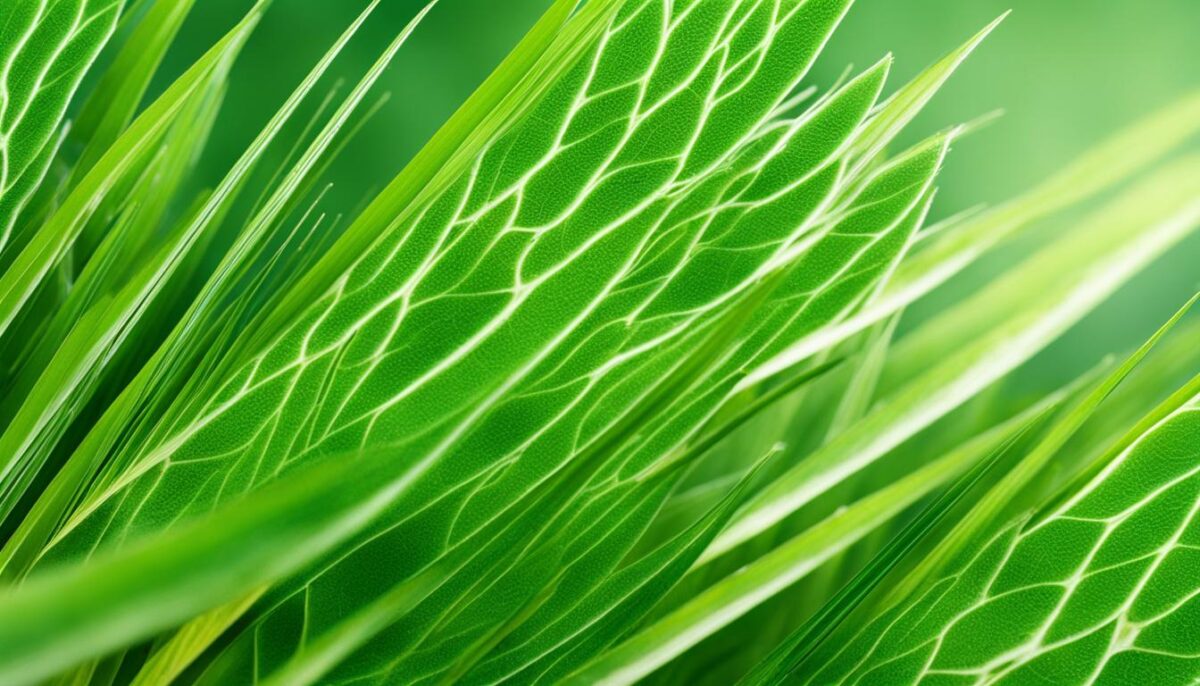Did you know that a horse’s equine diet naturally includes grass consumption? However, there are some potential dangers to their horse health that every horse owner should be aware of. In this article, we will explore the importance of equine nutrition and how to keep your horse healthy while enjoying grass. Let’s get started!
Key Takeaways
- Horses are natural grass eaters, but need to eat it in moderation.
- Overgrazing can lead to health problems like laminitis.
- Some horses are more prone to grass-related issues than others.
- Feed your horse hay and fresh grass for a well-balanced diet.
- Monitor your horse’s health closely, especially when introducing new grass.
- Limit grass intake with grazing muzzles or controlled pasture time.
- Watch for warning signs like warmth in the hooves or reluctance to move.
The Basics of Equine Diets and Grass Consumption
When it comes to the dietary needs of horses, understanding their natural diet and grazing habits is essential. In this section, we’ll delve into the role of fresh grass intake in an equine’s diet and explore the importance of managing equine grazing.
Understanding the Natural Diet of Horses
Horses are natural foragers, and their primary source of nutrition comes from grazing on grass. However, allowing a horse to consume grass all day can lead to overeating, particularly if they have limited food options. It is not uncommon for some horses to eat over 5% of their body weight in a day when grazing, which can result in obesity even without grain consumption. To counteract this issue, horses may need restricted access to grass or the use of a grazing muzzle to limit intake.
How Fresh Grass Fits Into an Equine Diet
While horses enjoy the taste of fresh grass, it is vital to note that it contains a high water content and lacks the necessary roughage needed to support proper digestion. Consuming only fresh grass can lead to irregular and wet feces, which could indicate digestive issues. It is recommended that horses have access to fresh grass but not exclusively; hay should also be provided to ensure their dietary needs are met. If you notice any signs of discomfort in your horse, such as indications of a stomachache or sore feet, it is crucial to consult a veterinarian for proper guidance and care.
By understanding the importance of a balanced natural diet for horses, learning about their foraging and grazing habits, and managing their fresh grass intake, you can better support your equine’s overall health and well-being.
Can Horses Eat Grass? Uncovering the Facts
So, can horses eat grass? The answer is yes, they can! However, it’s essential for horses to munch on grass in a safe and controlled manner to ensure their health. Some horses, especially those with a large middle and who don’t move much, referred to as “middle-aged obesity,” struggle with too much sugar from grass. These horses can develop a painful foot problem called laminitis, which can appear suddenly and cause severe discomfort.
When a horse experiences laminitis, veterinarians will typically recommend feeding them less and encouraging more movement. Yet, it can be challenging for horses to exercise when their feet hurt. To maintain a balanced and equine grass diet, it’s crucial for owners to monitor their horse’s grazing habits and ensure safe grass consumption for horses.
It’s essential to supervise your horse’s grazing habits, especially during seasonal changes when grass regrowth is rapid and lush. In these periods, horses must acclimate gradually to the fresh grass, ensuring they can safely digest the increased sugars without feeling ill.
By properly managing your horse’s grass intake and ensuring they receive hay as well, you can support their health and well-being. Always keep an eye on your horse for any signs of discomfort or distress, as prompt veterinary attention can make all the difference in helping them recover from any potential health issues.
Risks Associated with Grass in a Horse’s Diet
While grass is a natural part of a horse’s diet, too much fresh grass comes with some hidden risks. Understanding and managing these dangers is crucial to maintain your horse’s overall health, especially their hoof health. In this section, we will discuss the dangers of excessive fresh grass intake and the harsh reality of laminitis for grazing horses.
Dangers of Excessive Fresh Grass Intake
Excessive consumption of fresh grass can pose significant dangers to your horse’s health due to the presence of fructans in grass, a type of sugar that horses have difficulty digesting. Overindulging in fresh grass, especially in the spring when the fructan content is highest, can lead to equine overfeeding and an unhappy and unhealthy horse.
Laminitis: A Harsh Reality for Grazing Horses
One serious condition that can result from consuming too many fructans is equine laminitis, an incredibly painful inflammation affecting a horse’s hooves. Laminitis can be severe enough to be life-threatening if not managed properly, so prevention is key. Keeping an eye on your horse’s grazing habits and limiting their fresh grass intake, especially during high-risk seasons such as spring, can help reduce the grazing risks and protect your horse’s hoof health.
Recognizing and Preventing Overgrazing Issues
It is crucial to monitor your horse’s grazing habits to avoid overgrazing, which can lead to health issues. Keeping an eye out for certain signs and implementing effective strategies can help you maintain your horse’s well-being.
Signs That Your Horse Is Eating Too Much Grass
If overgrazing is occurring, you may notice some signs in your horse, such as excessively wet manure or warm hooves. They might also appear reluctant to move or constantly shift their weight. These indicators suggest that your horse is consuming more grass than required, and you should consider reducing their pasture time.
Strategies to Control Grazing and Maintain Health
There are several approaches that can help you control your horse’s grazing habits and ensure their health at the same time. First, allow your horse to graze on fresh grass for limited periods while continuing to provide them with hay. You can also utilize a grazing muzzle, which restricts the amount of grass your horse can consume. Another option is to create a designated area without grass, called a “dry lot,” for your horse to spend time in. Always be vigilant for signs of discomfort or warm hooves, and consult a veterinarian if you have concerns.
FAQ
Can horses eat grass?
Yes, horses can eat grass. However, it’s essential to monitor their intake and ensure they’re consuming the right types and amounts to maintain their health and avoid issues like laminitis.
What is the natural diet of horses?
The natural diet of horses includes grass and other forage, such as hay. Horses are grazing animals that are adapted to consume large amounts of fibrous vegetation throughout the day.
How does fresh grass fit into an equine diet?
Fresh grass is a nutritious and palatable food source for horses. However, it should be introduced gradually into their diets, to prevent excessive intake and potential health risks like laminitis due to the high fructan content in some grass varieties.
What are the risks associated with grass consumption in horses?
Risks associated with excessive grass consumption in horses include overfeeding, obesity, digestive issues, and laminitis. Monitoring your horse’s grazing habits and ensuring they receive a balanced diet can help mitigate these risks.
What is laminitis?
Laminitis is a painful and debilitating condition that affects a horse’s hooves, particularly the sensitive laminae. It can result from various causes, including excessive grass consumption (especially high-fructan grasses), obesity, illness, or trauma.
How can I recognize overgrazing issues in my horse?
Signs of overgrazing include wet and abnormal manure, warm hooves, reluctance to move or constant weight-shifting, and overall discomfort. Observing your horse’s behavior and physical changes can help you identify any grazing issues early on.
What strategies can I implement to control my horse’s grazing and maintain their health?
Strategies to control grazing and maintain your horse’s health include introducing fresh grass gradually, providing hay alongside grass, using grazing muzzles, and creating a dry lot for your horse to spend time in. Additionally, monitoring your horse for any signs of discomfort and consulting your veterinarian if needed can help you maintain your horse’s health.


